Life gets easy when there is an easy handy guide to it! We can’t guarantee a guide on it, but we surely have one, for your puppy’s leash training!
Like every child has its own learning pace, the same is true for your cuddly little fluffy pups.
And leash training your puppy to walk is one such training that requires a lot of practice and patience.
So, below we have mentioned a detailed guide on “How to teach a puppy to walk on Leash?” with a handy guide and relevant important information.
Key Takeaways
- There are no written rules for leash training your new pup, but patience is key.
- Prompt your puppy with the word “walk” and reward them with treats.
- Practice inside first, then take it outdoors. Be consistent and use an upbeat, strong voice to encourage good behavior. Do not pull on the leash or scold your puppy.
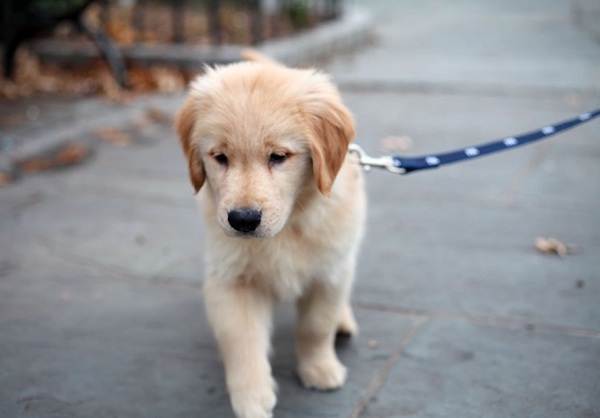
Leash Training A Puppy: Guide 101
This Leash training puppy guide includes all the rules, terms, and things to keep in mind.
It covers all important aspects of leashing and training a puppy for a new dog parent.
But keeping these points in mind, before you begin their leash training, is sure to make leash training a pup easy.
No Hard and Fast Rules
There are no written rules for leash training your new pup. One piece of advice that is fondly given to a new pup parent is, Patience is the Key!
As eager as you might be to see your pup walking and wagging its tail. But leash training a puppy requires persistence and lots of practice!
Give a new pup time to settle in a new environment and sniff and explore its new world. Let them start while playing with their collars and chewing their leashes.
Be a Leader
As a new pup learning to be a big loyal companion, your pup needs someone to command and teach. Learn to take a lead!
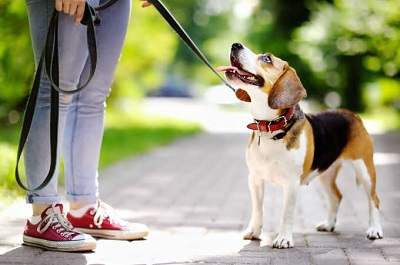
You need to be their leader and lead their paws for short walks or strolls around the house.
Leading them in the early days will make them learn to follow you,
Taking the lead first also makes them understand that they have to follow you and not the other way around!
Lead them by calling their name, petting their backs, and giving them treats.
You won’t find them following your command on the first go, but forming a habit of it way often will surely make them follow you.
As they need to be called a good doggo!
Start With a Collar
For leashing training your pup, always start with a collar and never a leash. Your pup needs to be confident and comfortable with a collar first before they get tied with a leash.
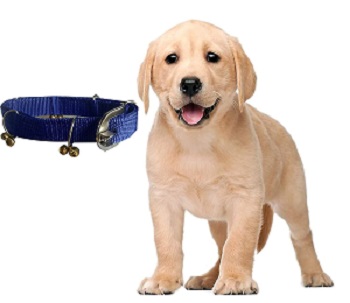
Select a collar with bright color and a squeaker that draws their attention. This will help them to entice towards the collar, and be comfortable wearing it.
Get the Right-Sized Leash
For buying a puppy’s first leash take a proper measurement of its neck. The leash shouldn’t be too tight or loose.
To start with, a simple, light collar and light leash are great and allow your puppy to get used to having something around his neck.
Prompt those Puppy Steps
After getting habituated to a collar and leash, it is necessary to allow them to walk on their own.
Make them wear a collar and leash for a few mins to hrs, while they play or eat.
Prompt them with the word “walk” and treat them as they walk around the house.
Pet and Reward Their Learning Behavior
A pup would be more energetic and curious to learn new habits or tricks or even training if they are rewarded right.
Petting them right and rewarding their favorite treats will get them prepared for more training sessions.
First Practice Inside
Now as your pup understands the command and reward. Start by holding its leash and walking along with your pup in the home first.
The pup has already got adapted to walking with a collar and its leash.
But they need to get adapted to you walking along and besides with them, now holding their leash.
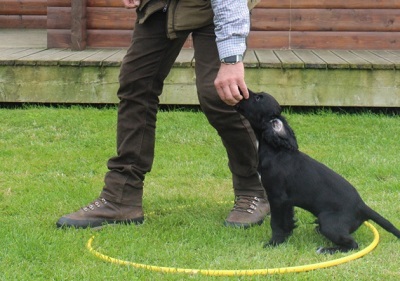
Start this leashing training for few times a day inside.
Begin the walk with a leash on your puppy with a treat and reward them a treat after they have completed it.
This will help your pup to feel the leash being held in your hands.
This leash training in-home is often referred to as ” Heel Training”. The word “Heel” refers to making your puppy walk by your side or at your heel, by holding a leash.
Finally, Take it Outdoors
After practicing leash training your puppy indoors, it’s now time to test their learning and training skills outdoors. Keep the first leash walks short and be careful.
While walking outside there will be fresh challenges because of all the exciting and new sounds, smells, and sights your puppy experiences.
How to Train a Puppy to Walk on a Leash Outdoors?
According to animalhumanesociety“While training your pup will take time and patience, you can teach your dog to walk on a loose leash with only a few pieces of equipment and some basic training techniques.” Now that you have started leash training your puppy outdoors, here are steps to follow.
Following these crucial 6 steps will serve to leash train your pup for outdoors. Let’s make your puppy leash ready!
1. Give them a Cue
Before starting your walk, entice to prepare your pup by giving cues. Fasten their harness on the collar and give them the treat to entice walking. A few cues like ” walk” and “treat”.
2. Be Leash Ready
Keep pup’s leash handy. Make sure to check the leash and its tightening before stepping out.
Make sure to treat your pup before you tighten a leash.
3. Always Carry Their Treats
For efficient leash walking with your pup, it is always a better idea to carry their treats. As treats are their reward and they can be trained for any new challenge for command in return favor of a treat.
However, it is not a good idea to constantly feed them treats while walking. Make sure to treat their good behavior and proper leashing walking.
4. Start it Slow and Steady
As the puppy learns to walk with a leash on, take the walking sessions slow and steady. It is never a good idea to change directions or their walking stride early.
5. Help Your Puppy Learn to Follow
After learning a steady leashing on walking, make sure your puppy follows you heal by heal. Always lead and never release them off the lease.
6. Be consistent and Make a Walking Routine
Leash training a puppy can be hard and takes time, but what matters more is making it a routine.
Always try to walk your puppy with a leash at least twice. This is particularly important in early learning days.
As practice would make leash training more perfect.
What Age to Start Leash Training a Puppy
The assumption that dogs should not be trained until they reach six months is not valid. As Per Guide Dog Foundation “You can start introducing loose leash walking as soon as you get your puppy.“
Nearly all behavior issues are already in progress and harder to fix by six months of age.
Your pup should also be aware of their routine at 10 weeks, such as when they are taken out and when they are expected to go to pee and poop. Besides, leash training is better combined with recall training.
Choosing the Right Collar and Leash
Training a puppy right also requires the selection of a proper collar and leash. A proper collar will ensure that the puppy stays comfortable in leash training.
The selection step sounds like an easy course, but there are several different options out there.
I prefer a soft flat collar at the beginning and a loose leash for a young pup. Later, if necessary, we can move on to other styles of collar.
How to Stop a Puppy From Pulling on a Leash?
Leash Pulling is the most common event for a dog. Be it a puppy learning leash training or an older dog every dog parent has been there.
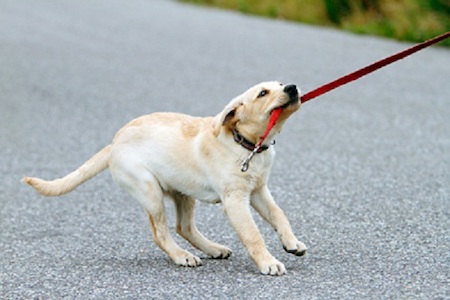
And the reason for leash pulling can be many, either they want to chase a squirrel, or they got hyper-excited seeing other furry buddies.
The reason can be multiple, but yes the owner needs to be in control of the leash pulling.
Turn yourself into “a rock” if your dog starts pulling in the other direction. Stand very still and refuse to move before your dog comes back to you.
Do not pull the leash or twist it, and do not drag your dog with you.
Don’t get angry and scold them if your puppy tries to pull on the leash. Just keep leash-training them with their favorite treats.
And always use an upbeat, strong, and encouraging voice to reward good behavior.
Your pup will soon start to understand and associate the right actions with treat rewards.
The Do’s And Don’ts of Leash Training a Puppy
The following easy and handy do’s and don’ts quick list allows dog parents to conduct happy leash training for their puppies.
The Do’s of Leash Training a Puppy
- Practice in different places. Puppies are always curious and want to explore and sniff new places. So if their routine leash training walks have bored them, try different places.
- Allow them to explore. Your leash training can be done peacefully and happily if they find enough things to keep them motivated to walk. Not just treats, allow them to explore the smells and new places.
- Always motivate your puppy. Give puppies more time for all the leashing training information to be processed. It takes a different pace for different puppy breeds to understand what the leash is and what it does. Let him gain trust in you and always encourage your pup.
The Don’ts of Leash Training a Puppy
- Avoid using a harness. Puppies are too small to be harnessed. Although a harness might seem a good idea to control your pup than a leash. But it in fact makes them more uncomfortable.
- Never Drag or pull the puppy. Sometimes out of energy or just being stubborn they might sit or lay down in leash training walks. But this should be no reason to pull or push them.
- Don’t use aggressive training Aids. Harsh training aids might teach them leash training easily and early. But it is not a healthy practice to follow especially for little puppies. This can cause a permanent state of fear or unhealthy behavioral changes.
Stopping Unwanted Behaviors While Leash Training a Puppy
While leash training your pup there might be unwanted behaviors exhibited by your tiny ones.
We have tried to solve and answer them. Yet we recommend every dog parent to be calm and relaxed while leash training a puppy.
When Your Puppy Lunges
Puppies with their always curious nature might try to lunge more in leash training.
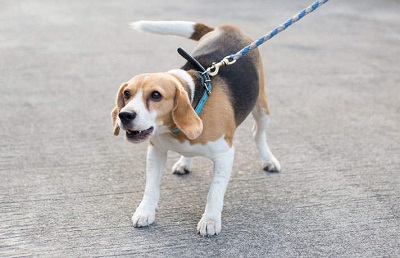
They simply can lunge over a squirrel or a big dog walking by! So in that case try to re-direct their attention with a treat.
And you can even slow down a bit to avoid distraction.
If Your Puppy Barks
Some puppy breeds can get too excited by seeing other dogs walking by and they just start barking.
Sometimes this happens even due to a lack of proper socializing skills in your pup.
In that case, you can encourage your pup to sit for a while until their distraction passes by. Or treat them to divert their attention to eating rather than barking.
When Your Puppy Starts Leash Biting
Leash biting is another common issue during leash training, besides leash pulling. Never reward a treat when your pup tries to bite the leash to divert their actions.
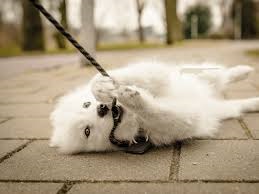
As rewarding this might signal them as good behavior.
You can redirect the leash biting to appropriate chewing toys and tools.
Leash biting may also mean that your pup is not comfortable with the leash and it might be pulling it. So try using a loose leash.
If your Puppy Jumps up for a Reward
This is the most common issue faced by dog parents while rewarding their pup on leash training. You can avoid this issue by following obedience training.
Make your pup clearly understand the term “Sit” and “Stay” before rewarding them. If they still jump up for a reward, wait for a while till they sit down and stay calm.
Practice Obedience Training while Leash training
It’s also a good advantage to begin obedience training by the time your dog can go out for walks.
It is an advantage to start your pup’s obedience training along with leash training.
Obedience training can be started as early as 3 months and not later than 6 months. Teaching obedience training will make leash training your puppy easy when outdoors.
Stick to simple commands such as “sit,” “stay,” “come,” “heel,” and “down,”. Use the same words and actions.
Relevant FAQs
At what age should you start leash training a puppy?
The ideal age is 8-10 weeks of actual leash training, which includes teaching them proper leash behavior.
Is a collar or harness better for a puppy?
This choice depends on the owner and the puppy. Some pups feel more comfortable with a harness as it keeps their neck free. Whereas some owners want to start with a light flat collar.
How to teach a puppy to heel?
Take a slight step forward when you say “Heel” with your dog beside you on your preferred walking side. Take their favorite treat in hand, lower it to their nose, and with your leg nearest to them. Say “Good” and reward them as your pup follows your move.
How do I get my puppy to enjoy leash training?
You can get your puppy to enjoy leash training by rewarding them with their favorite treats. Always reward your pup, before beginning their leash training and after completion.
Conclusion
So, hope our above article helps you leash train you train your pup effectively and easily.
References:
- (2022d, September 6). Tips for Leash Training Your Dog. PetMD. https://www.petmd.com/dog/training/evr_dg_tips-for-how-to-leash-train-a-dog
- (n.d.). Behavioural Evaluation of a Leash Tension Meter Which Measures Pull Direction and Force during Human–Dog On-Leash Walks. MDPI. Retrieved December 1, 2022, from https://doi.org/10.3390/ani10081382
- Donovan, L. (2021, September 7). How to Teach a Puppy to Walk on a Leash. American Kennel Club. https://www.akc.org/expert-advice/training/teach-puppy-walk-leash/
Contents
- Leash Training A Puppy: Guide 101
- How to Train a Puppy to Walk on a Leash Outdoors?
- What Age to Start Leash Training a Puppy
- Choosing the Right Collar and Leash
- How to Stop a Puppy From Pulling on a Leash?
- The Do’s And Don’ts of Leash Training a Puppy
- Stopping Unwanted Behaviors While Leash Training a Puppy
- Practice Obedience Training while Leash training
- Relevant FAQs
- Conclusion

When it comes to dogs, Julia ignores nothing. Being an animal behaviorist, dog trainer and a dog parent she knows exactly how even a tiny change in a dog’s surroundings and diet can leave dogs disturbed for a longer duration. Hence, she always makes sure to review for us only the best products for dogs out there.


